

Elk, Elk Pictures, Elk Facts. Elk are also called wapiti, a Native American word that means "light-colored deer.

" Elk are related to deer but are much larger than most of their relatives. A bull (male) elk's antlers may reach 4 feet (1.2 meters) above its head, so that the animal towers 9 feet (2.7 meters) tall. Bull elk lose their antlers each March, but they begin to grow them back in May in preparation for the late-summer breeding season. In early summer, elk migrate to high mountain grazing grounds where the cows (females) will give birth. Each cow typically has a single calf, which can stand by the time it is 20 minutes old. During the late summer breeding season the bugling of bull elk echoes through the mountains. In the winter, wapiti reconvene into larger herds, though males and females typically remain separate. Elk were once found across much of North America but they were killed off and driven to take refuge in more remote locations. Steppe. A steppe is a dry, grassy plain.
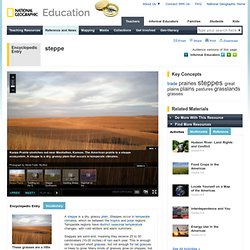
Steppes occur in temperate climates, which lie between the tropics and polar regions. Temperate regions have distinct seasonal temperature changes, with cold winters and warm summers. Steppes are semi-arid, meaning they receive 25 to 50 centimeters (10-20 inches) of rain each year. This is enough rain to support short grasses, but not enough for tall grasses or trees to grow. Many kinds of grasses grow on steppes, but few grow taller than half a meter (20 inches). Eurasian Steppe. What Kind of Flowers Are Found in Temperate Grasslands? Sus scrofa. Geographic Range Wild boars (Sus scrofa) are a cosmopolitan species.
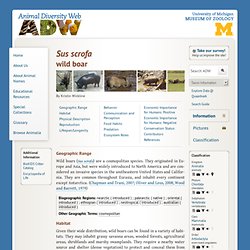
They originated in Europe and Asia, but were widely introduced to North America and are considered an invasive species in the southeastern United States and California. They are common throughout Eurasia, and inhabit every continent except Antarctica. Taiga Biomes. A biome is the type of habitat in certain places, like mountain tops, deserts, and tropical forests, and is determined by the climate of the place.
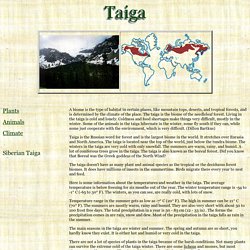
The taiga is the biome of the needleleaf forest. Living in the taiga is cold and lonely. Coldness and food shortages make things very difficult, mostly in the winter. Some of the animals in the taiga hibernate in the winter, some fly south if they can, while some just cooperate with the environment, which is very difficult. (Dillon Bartkus) Taiga is the Russian word for forest and is the largest biome in the world. The taiga doesn't have as many plant and animal species as the tropical or the deciduous forest biomes. List of Plants in Temperate Grasslands. Temperate grasslands consist of either prairies with tall grasses or steppes with short grasses.

Each type contains a wealth of flowers and other flora. Prairies also have groves of trees that grow alongside streams and creeks. The plants in grasslands offer a wide variety of resources for the birds, animals and insects that rely on them for shelter, food and nesting habitats. Buffalo Grass Found throughout the Great Plains, buffalo grass (Buchloe dactyloides) grows in both prairie and steppe grasslands, where it reaches up to 10 inches high. Common Sagebrush A plant of the steppe grasslands, common sagebrush (Artemisia tridentata) grows in the dry areas of the western United States. Basic Facts About Marines. Oceans cover approximately 70% of the earth’s surface with an average depth of 2.4 miles, or 3,800 meters.
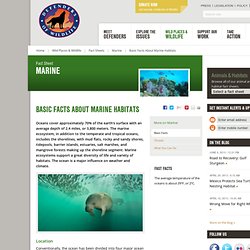
The marine ecosystem, in addition to the temperate and tropical oceans, includes the shorelines, with mud flats, rocky and sandy shores, tidepools, barrier islands, estuaries, salt marshes, and mangrove forests making up the shoreline segment. Marine ecosystems support a great diversity of life and variety of habitats. Marshy Point Nature Center - Home. Montana Field Guide. Search Field Guide Advanced Search Montana Field Guide Help Montana Field Guides Rocky Mountain Montane-Foothill Deciduous Shrubland No photos are currently available If you have a high quality photo of this Ecological System, are confident in the identification, and would like to submit it for inclusion on the Montana Field Guide, please send it to us using our online photo submission tool.
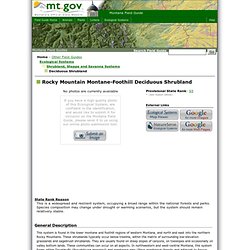
National Parks & Monuments Found in the Grassland Biome. Ethan Schowalter-Hay, Demand Media Grasslands are broad, open places of billowing grass, yawning horizon, soaring birds of prey and grazing animals.

Whether it is a Wyoming shortgrass prairie, a savanna in Africa’s Great Rift Valley or a windswept steppe in Mongolia or Russia, these ecosystems invite exploration with their stark beauty and rolling vistas. While many remain unprotected, some national parks have been established in grassland environments around the world. Background. Our Biome. Background: The temperate grassland biome pretty much describes itself in its title.
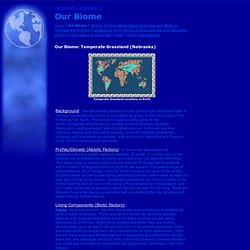
Temperate Grassland is dominated by grass. It also has some of the richest soil on Earth. Plant Life of the Grasslands. Prairie Dogs, Prairie Dog Pictures, Prairie Dog Facts. These charismatic, rabbit-size rodents live on North America's prairies and open grasslands in only a fraction of their former numbers.
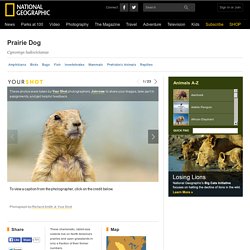
Prairie dogs live in underground burrows, extensive warrens of tunnels and chambers marked by many mounds of packed earth at their surface entrances. Burrows have defined nurseries, sleeping quarters, and even toilets. They also feature listening posts near exits, so animals can safely keep tabs on the movements of predators outside. Prairie dogs spend a lot of time building and rebuilding these dwellings. Other animals benefit from their labors. Family groups (a male, a few females, and their young) inhabit burrows and cooperate to share food, chase off other prairie dogs, and groom one another. Prairie:Ecosystems:Animals:Adaptations. Raccoon dog - night wandering raccoon - pictures and facts. The Raccoon Dog (Nyctereutes procyonoides) is an omnivore native to Japan, the south-east of Siberia, and Manchuria, but they have also been sighted in Europe recently.
During winter they hybernate, having fattened themselves during autumn on frogs, lizards, rodents, and even birds. They supplement their diet with seeds and berries. They are threatened by humans through hunting for their fur and urbanization. Its Greek scientific name Nyctereutes procyonoides comes from nycto = night, ereutes = wanderer, procyon = raccoon, although it isn't a raccoon, it's closest living relatives being foxes. They grow to lengths of about 65 cm and can weigh up to 10 kilograms. Rainforests Facts. Facts about Rainforests Do you know how many tropical rainforest plants have been identified as having anti-cancer properties?
Or how many continents around the world contain rainforests? And just how quickly are the world's rainforests disappearing? Find out the answers to these questions and more as you check out these interesting rainforest facts! And when you think that you know all there is to know about the rainforest, test your knowledge with our rainforest quiz. Facts about the Global Coverage of Rainforests Covering less than 2 percent of the Earth's total surface area, the world's rainforests are home to 50 percent of the Earth's plants and animals.
Saiga Antelope. A distinctive bulbous nose makes the saiga an unlikely pin-up for the conservation movement. Habitat loss and illegal hunting have dramatically cut population numbers. Physical description The large humped nose hangs over the mouth of the saiga. The nose is flexible and inflatable so helps it to breathe clean air during dusty summers and warm air during cold winters. Its coat is sparse and cinnamon coloured during the summers, turning to a very thick white coat during the winters. Saiga antelope has long, thin legs but is similar in size to a sheep. Weight: 30 - 50kg (males) and 21 - 40kg (females) Shoulder height: 60 - 80cm, males are usually taller than females. Screaming Hairy Armadillo (Chaetophractus vellerosus) Description from View on Wikipedia → The screaming hairy armadillo (Chaetophractus vellerosus) is a species of armadillo also known as the small screaming armadillo, crying armadillo or the small hairy armadillo.[3][4] It is a burrowing armadillo found in the central and southern parts of South America.[2] The adjective "screaming" derives from its habit of squealing when handled or threatened.[4] Taxonomy[edit] The animal was first described by Dr J.
E. Semi-arid Grasslands and Shrublands of the Colorado Plateau. Semi-arid Grasslands and Shrublands Below 6,000 feet in the cool-temperate region of southern Utah, northern Arizona, and northwestern New Mexico several different types of native grasslands were once common. The two most dominant were a Great Basin grassland, typical of the more western, central, and northern regions, and a Plains grassland, which is confined to the southeastern part of the region. Plains grasslands are commonly dominated by Blue Grama or other gramas that extend into the area from southern Colorado and northwestern Texas. Great Basin grasslands are dominated by Galleta Grass and Indian Rice Grass and reach down to the Colorado Plateau from the northwest. Both types intergrade downslope with semi-arid scrub communities and upslope with pinyon-juniper woodlands. A large transitional area between the two types occurs in north-central Arizona and extreme southern Utah.
Research: Stampede Buffalograss. Stampede Buffalograss. Steppe. In physical geography, a steppe (from Russian: степь, tr. step', IPA: [sʲtʲepʲ] ( Facts About Buffalo Grass. Buffalo grass (Bouteloua dactyloides) was a primary food source for the large herds of bison roaming the plains in years past, hence the name. It is today used primarily for cattle and other livestock on ranches in its native region. Lawns of buffalo grass consist of both male and female plants when established naturally. Prairie Dogs, Prairie Dog Pictures, Prairie Dog Facts. Grasslands Biome. Foxes That Live in Temperate Grasslands. Foxes That Live in Temperate Grasslands. Temperate Grassland Animals. Temperate Grassland Biome. Temperate Grassland Omnivores? - Ask.
Temperate Grasslands. Temperate Grasslands and Plant Adaptations. The extensive root systems of prairie grasses prevent grazing animals from pulling roots completely out of the ground. In addition, the roots grow deep down into the ground to absorb as much water as possible. During fires, the above ground portion of grasses are destroyed while the deep roots survive to sprout again, according to the Missouri Botanical Garden website. Grasslands.
Grasslands. Modern agriculture does make some nods to these problems. Grasslands Biome. Basic Facts About Grasslands. Temperate Grasslands. Location. Information About Buffalo Grass. Information About Buffalo Grass. Overview Buffalo grass is a perennial turf grass that produces soft, blue-green curly blades and spreads easily through rhizome growth. The grass is a warm-season variety that can be planted either by seed or grass plugs in the spring or fall season. Interesting Facts About the Temperate Grassland. Interesting Facts About the Temperate Grassland. Temperate grasslands serve as a transitional land feature between forests and deserts. KDE Santa Barbara. Land Biomes: Temperate Grasslands. Landforms of the Grasslands Biome. Temperate Grasslands Facts. Grasslands. GRASSLANDS. Life in the Taiga. Grassland Biome. Animals of the Temperate Grassland.
Animals That Live in a Grassland. Badger - Animal Facts. What is an example of a food chain in the temperate grassland biome? - Ask. Animal Adaptations for Temperate Grasslands. Animals and Plants in Temperate Grassland. Temperate Grasslands. Temperate Grasslands, Savannas and Shrubland Ecoregions. What are some plants found in temperate grasslands. Grass - Temperate Grasslands. Typical Plant Types of the Temperate Grassland Biome. Weasel (Mustela nivalis. What are plant adaptations to grasslands. What are unique facts about temperate grasslands. What is the weather like in the temperate grasslands. What kind of insects are found in the temperate grasslands (prairies, steppes, etc)
What Kinds of Animals Live in Temperate Grasslands? What Kinds of Animals Live in Temperate Grasslands? Wild Boar (Sus scrofa. Grassland Animal Adaptations. Endangered Animals in Temperate Grasslands. Steppe (Grassland) - University of Puget Sound. 10 Grasslands Facts. 3.5-001CS.ungulatesAndes. 609 Buffalograss. [Biomes - Living Worlds] Facts on a Grassland Ecosystem. [Biomes - Living Worlds] American Bison - Temperate Grasslands. American Bison, American Bison Pictures, American Bison Facts. Animals and Plants in Temperate Grassland. Chaparral Biome. Climate in Temperate Grasslands. Common Sagebrush - Artemisia tridentata. Basic Facts About Deserts.